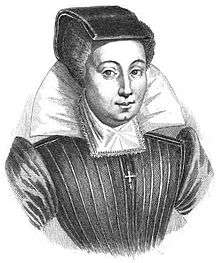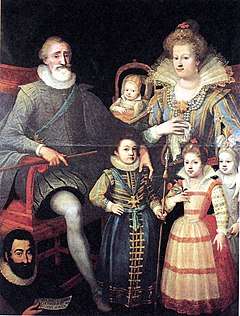Louise Boursier
Louise (Bourgeois) Boursier (1563–1636) was a French midwife. Marie de Médicis the wife of Henry the Great of France was one of her patients and delivered her six children. As a Royal Court midwife for twenty-six years Boursier made about ten time what the average midwife made.
Louise Boursier | |
|---|---|
 | |
| Born | 1563 |
| Died | 1636 (aged 72–73) |
| Citizenship | French |
| Education | Diploma and license to practice midwifery |
| Known for | Scholarly writings on midwifery, midwife to French royal family |
| Spouse(s) | Martin Boursier |
| Scientific career | |
| Fields | midwifery |
| Institutions | court of Henry IV of France |
| Patrons | Queen Marie de Médicis and French King Henry the Great |
Boursier was known as a scholar and educator. Through her common-sense-based medical methods and prodigious writings she helped raise midwifery to state of the art science. She was the first woman to write a book on obstetrics. That was further expanded by other more detailed medical works by her and her descendants that was used by medical professionals in several countries.
Early life
Bourgeois was born sometime in 1563[1] in what was then a farming area outside of Paris called, the Faubourg Saint-Germain.[2][3] Her family was not of noble ancestry, but her father was a builder that constructed houses at the village of Bussy, fifteen miles north of Paris.[1] She was raised in upper middle-class circumstances. She received an education customary of the children of families of that class.[4]
Bourgeois' family lived near the barber surgeon medical professional Martin Boursier, who was a pupil-assistant of Ambroise Pare.[4] Bourgeois married Martin Boursier at the parish of Saint Sulpice in 1584.[5] They moved to Faubourg Saint-Germain sometime between 1586 and 1587. The couple had a comfortable life style there and three children were born by September 1589.[3]
King Henri IV attacked Paris in October of 1589. Bourgeois was home alone with her three children at the time. Her husband was out of the country away on duty in the army. She abandoned her rural home and most of their possessions when she retreated with her children and mother behind the city walls of Paris for protection.[6] For an income then Bourgeois took up needlework and sold items she embroidered and pieces of valuable personal items she managed to save. This however still was barely enough income to support her family.[4]
Bourgeois' husband returned from the army sometime around 1591, but his income as a medical doctor was not enough to support the family. While Louise had their third and last child her nurse at the time suggested she go into midwifery.[7] She took up midwifery part-time in the 1580s and by 1593 had joined the Guild of Midwives as a professional. Bourgeois learned this medical skill from her husband and by going to a new college for midwives at the hospital Hôtel-Dieu de Paris.[4]

Career
Bourgeois obtained a diploma and license to legally practice midwifery in 1598 when she passed the examination for that profession and became a registered midwife.[8] The judging panel consisted of a medical doctor, two barber-surgeons, and two well respected professional midwives.[9] She then moved with her family into a fashionable house on the Left Bank at the rue Saint-Andre´des-Arts. There she built up a large scale medical practice in the Latin Quarter. She built an excellent reputation in the delivery of two thousand babies and was well liked as a professional midwife.[10] She was known as a scholar and educationalist because of her advanced knowledge in the field that she wrote on in various manuscripts.[11] With her husband she headed a minor medical dynasty that ran down through her family that lasted for decades.[12]
Henry the Great of France married Marie de' Medici in 1600. Their first child was due in 1601.[2] The King wanted to employ Madame Dupuis to be the royal midwife. Marie de' Medici chose Bourgeois instead, as she had successfully assisted the childbirths of several young ladies of the Royal Court and had an excellent reputation as a professional midwife.[13] Bourgeois writes her experience on this first childbirth of Queen Marie in her 1617 book True accounts of the births of the royal children of France.[14]
Between 1601 and 1610 (when Henri IV was killed) six children were born to Marie de' Medici, all assisted by Bourgeois. They were Louis XIII, future King of France (1601), Elizabeth, Queen of Spain (1602), Christine Marie, Duchess of Savoy (1607), Nicolas Henri, Duke of Orléans (1607), Gaston, Duke of Orléans (1608), and Henrietta Maria, Queen of England, Queen of Scots and Queen of Ireland (1609). Bourgeois received 500 livres (crowns) of money for each son delivered and 300 livres for each daughter.[2] The average midwife at the time had an income of 50 livres for each delivery.[15] Bourgeois's career as a royal court midwife had spanned over twenty-six years.[10]
Later life
Bourgeois was ultimately awarded in 1608 a lump sum of 6,000 livres for her services as royal midwife.[2] After the birth of Henrietta Maria, the last child, Bourgeois asked for a pension of 600 livres per year. King Henry IV agreed in 1610 to 300 livres, which was considered a reasonable retirement income.[15]
In her "retirement" Bourgeois wrote a great deal and made important contributions to obstetrics. She wrote a book on childbirth practices in 1609 and was the first woman to write such a book.[16] The last section of this book, titled "Advice to my Daughter," displays Bourgeois' opinions on various topics. She tells her daughter to fear God, to attend the poor with charity, and to never let unmarried women into her house for confinement or to assist in abortions. She also criticizes the women of her time for preferring male physicians to midwives [7] Additional techniques and information were added in 1759 by her descendant, Angelique le Boursier du Courdray, who was also a royal French midwife.[17] She in turn passed this knowledge down to poor women of her time.[18]
Although she was technically retired as a royal midwife, Bourgeois still delivered children. In 1627, she delivered the child of the Duchess of Orleans. Unfortunately, the duchess died from fever after her labor. Male physicians (many of whom were enemies of Bourgeois) wrote the autopsy report, and said that a piece of afterbirth was left on the womb, implying that Bourgeois had left it there and was at fault for the duchess' death. In response to this, Bourgeois wrote the "Apology of Louise Bourgeois," in which she questions the validity of the report.[19] In her 'apology', Bourgeois highlights her many qualifications, and says she had practiced the midwife profession for thirty-four years. She points out that she honorably acquired the proper certificate and wrote books on midwifery that was used by physicians in several countries for years. She described herself as the first woman midwife to write on the subject.[2]
Works
- 1609 - Various Observations on the Sterility It was the first book on midwifery and childbirth written by a woman.[17] It had practical information on obstetrics. Few texts of this type existed at the time. Her book, which contained references to some 2000 childbirths,[20] was translated into various languages and used until the 1700s.[21]
- 1617 - Diverse Observations, expanded edition of above obstetrical theory.
- 1626 - Diverse Observations, expanded edition of above obstetrical theory with treatments for anemia.
- 1634 - Collection of Secrets, treatments like podalic version
See also
References
- Goodell 1876, p. 6.
- Dunn, PM (2004). "Louise Bourgeois (1563-1636): royal midwife of France". Arch Dis Child Fetal Neonatal Ed. 89 (2): F185-7. doi:10.1136/adc.2003.037929. PMC 1756029. PMID 14977911.
- Perkins 1996, p. 15.
- "Mother of midwifery with a cure of iron". The Guardian. London, England. December 14, 1993. p. 60 – via Newspapers.com

- Chereau 1875, p. 5.
- Christensen 2012, p. 100.
- Goodell, William (5 June 1876). "A sketch of the life and writings of Louyse Bourgeois, midwife to Marie de' Medicine, the queen of Henry IV. of France. The annual address of the retiring president before the Philadelphia County Medical Society". Philadelphia, Pennsylvania: Collins, printer. pp. 1–52. Retrieved 18 December 2016.
- Robin 2007, p. 57.
- Perkins 1996, p. 17.
- Christensen 2012, p. 102.
- Lander 2015, p. 134.
- Perkins 1996, p. 26.
- Perkins 1996, p. 18.
- Read 2016, p. 58.
- Perkins 1996, p. 23.
- Proffitt 1999, p. 53.
- Anzovin 2000, p. 115.
- Gelbart 1998, p. 263.
- Proffitt 1999, p. 50.
- Perkins 1996, p. 24.
- "/ Louise Bourgeois (French midwfe)". Encyclopedia of World Biography. 2005. Retrieved August 17, 2020.
Sources
- Anzovin, Steven (2000). Famous First Facts. H. W. Wilson Company. ISBN 0-8242-0958-3.
Item # 2338 - The first woman to write a book on childbirth was Louise Boursier (1563-1636), teacher, author, and midwife to the French court for 27 years. In 1609, she wrote a book on midwifery and childbirth practices that was expanded in 1759 by her descendant, Angelique le Boursier du Courdray, who was also a midwife.
CS1 maint: ref=harv (link)
- Christensen, Thomas (2012). 1616: The World in Motion. Counterpoint Press. ISBN 1582437742.CS1 maint: ref=harv (link)
- Chereau, Achille (1875). Marie de Medici Queen of France and Navarre six deliveries. Willem Press. OCLC 457118315.CS1 maint: ref=harv (link)
- Gelbart, Nina Rattner (1998). The King's Midwife: A History and Mystery of Madame du Coudray. University of California Press. ISBN 978-0520221574.CS1 maint: ref=harv (link)
- Goodell, Williams (1876). Life and writings of Louise Bourgeois, Marie de' Medici's midwife. Collins Philadelphia, printer. OCLC 221091695.CS1 maint: ref=harv (link)
- Lander, Bonnie (2015). Chastity in Stuart Literature & Culture. Cambridge University Press. ISBN 9781107130128.CS1 maint: ref=harv (link)
- Perkins, Wendy (1996). Midwifery and Medicine in Modern France. University of Exeter Press (UK). ISBN 0-85989-471-1.CS1 maint: ref=harv (link)
- Proffitt, Pamela (1999). Notable women scientists. Gale Group, Farmington Hills, Michigan. ISBN 0-7876-3900-1.CS1 maint: ref=harv (link)
- Read, Kirk D. (2016). Birthing Bodies in Early France. Tayloy & Francis. ISBN 978-1317-17407-3.CS1 maint: ref=harv (link)
- Robin, Diana (2007). Encyclopedia of Women in Renaissance. ABC-CLIO. ISBN 9781851097722.CS1 maint: ref=harv (link)